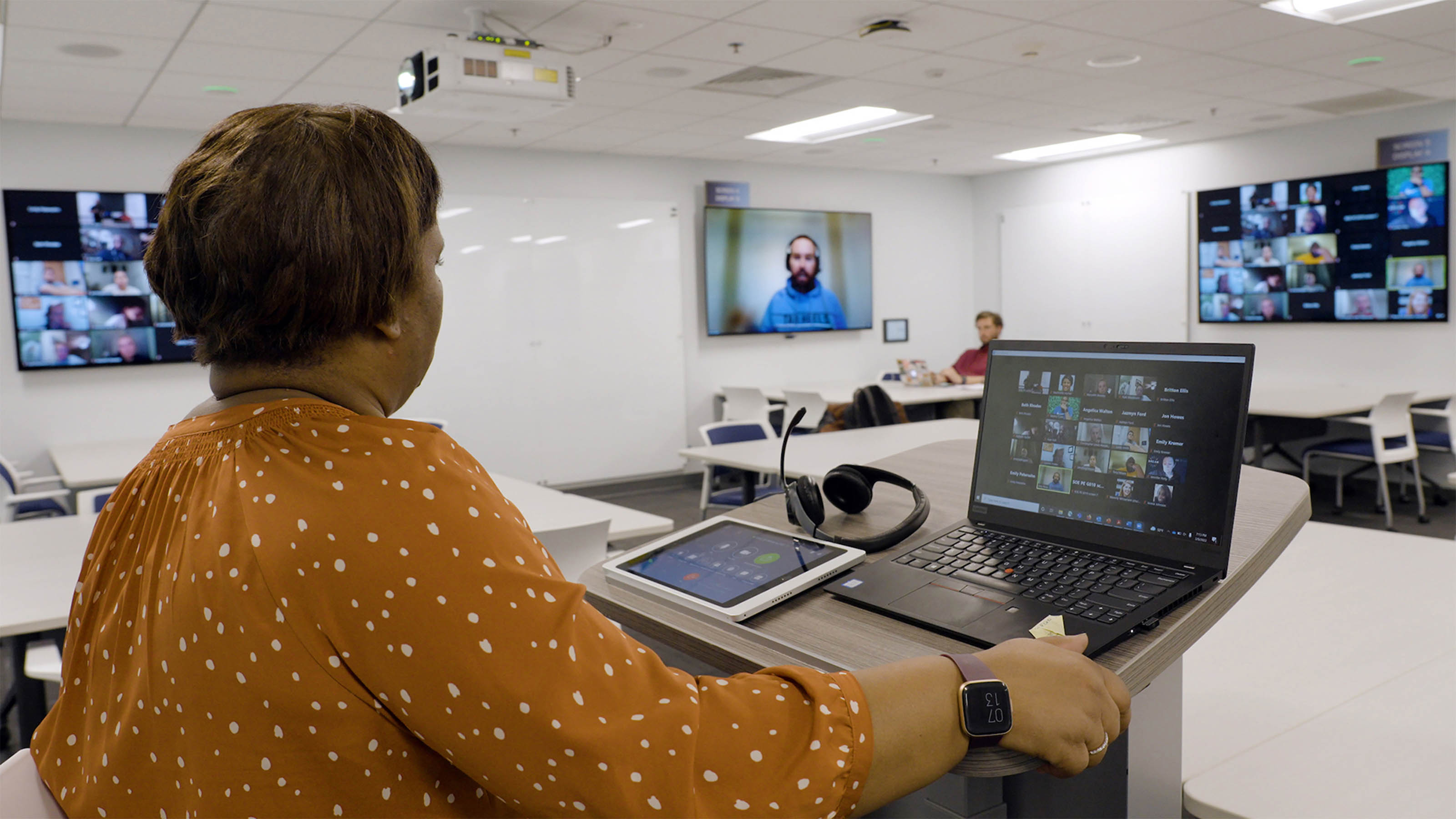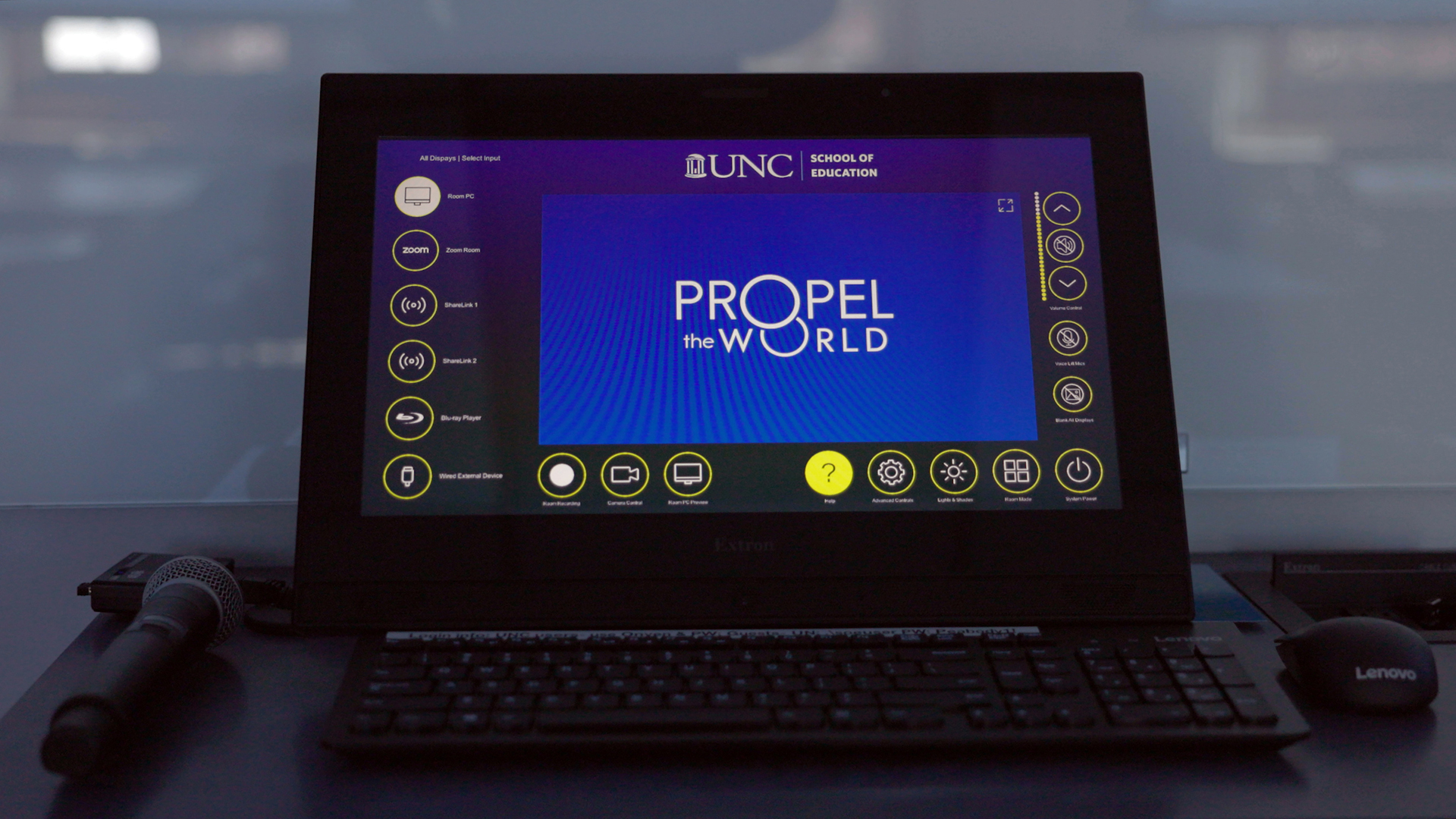The Future of Education Is Present
The UNC Chapel Hill School of Education expands its reach with HyFlex classrooms.

Prior to the pandemic, the technology team that serves the UNC School of Education at the University of North Carolina at Chapel Hill began planning for a major technology upgrade. Fouad Abd-El-Khalick, dean and alumni distinguished professor at the UNC School of Education, was pushing the institution to embrace an agile approach to teaching and learning.
[The Integration Guide to Education 2023]
The result: two HyFlex, agile classrooms that enable instructors and students to seamlessly connect, both on site and from remote locations. The university worked with Kontek, an AV design and integration firm headquartered in Durham, NC, on the design and deployment of the technology.
Room Modes
The system is built on Extron NAV AV over IP distribution infrastructure. Each room features eight Sony LCD displays—two per wall—as well as an Epson projector for the display at the front of the class.
On the user interface, Basic Mode shows the same source on every screen. For Dual Content Mode, the left screen may display the tile view of remote participants, while the right screen may display shared content or the active speaker. During class, instructors may also break students out into multiple Zoom Rooms. A portable iPad provides control over the entire space, while instructors and participants use two mounted iPads for breakouts.
“[For breakout sessions,] there are the two displays up front and then that’s mirrored all the way around the room—left/right on all four walls,” explained Calvin Groves, previously IT director at the UNC School of Education, now director of the university’s ITS service desk. “When you go into breakout mode, three of the screens then have an associated Zoom Room [connected] to them. So, if you want to do eight breakouts—which the rooms could do—five of them would be local content, but then the other three could engage remote participants.”
A daily selection of the top stories for AV integrators, resellers and consultants. Sign up below.

Connell Smallwood, CTS, UI/UX control system programmer at Kontek, worked with Groves to deliver a user interface that simplified control of these spaces as much as possible. He said the UI features five discrete room modes: basic, dual content, breakout (in-person), breakout (HyFlex), and Zoom host.
“Via the deployed Extron NAV system, the eight in-room video outputs are automatically routed to display matching content, near/far end Zoom Room, dual selectable content, breakout sources, or breakout sources with Zoom Room breakouts,” Smallwood explained. “Audio zoning is also taken care of seamlessly with the selection of a room mode.”
Equity Emphasis
Smallwood underlined the importance of delivering a solid experience to both in-person and online students. “We wanted to make sure their experience was as close to being in the actual classroom environment as possible,” he said. “In the Basic Room mode, both teacher and students anywhere in the room can be heard clearly by the far end with the strategic deployment of Biamp’s Parlé TCM-XEX mics throughout the space.”
The Biamp mics are assigned zones when used in Breakout Mode. Biamp in-ceiling speakers are also deployed in both classrooms.
Groves admitted that what Kontek and Biamp achieved for the audio system was "a little bit of magic to me. But when you’re in the area where you’re supposed to be heard, you’re heard, and if you’re just a little bit away, you’re either not heard at all or [the volume is] really low, where it doesn’t interfere.” Multiple breakout sessions can take place “without the crazy audio feedback loop that you’d expect," he added.

Panasonic PTZ cameras, in combination with a classroom wide-view camera, enable remote participants to see what is happening in the spaces. Jabra Panacast cameras are used during Zoom Room breakout sessions.
“The main goal of an application this complex is to make sure the end users do not feel the pressure [or] anxiety of said complexity,” Smallwood explained. “I’m confident this was achieved by a thoughtful user interface provided on the 17-inch Extron touchpanel, in addition to the numerous mics and cameras available for use.”
Roomies Vs. Zoomies
At the UNC School of Education, the affectionate term for in-person students is “roomies,” while remote students are (with equal affection) referred to as “zoomies.” In a Kontek video case study on this project, Martinette Horner, clinical assistant professor, emphasized her need to reach both groups.
“I have a value to make sure that class is still [one], where it doesn’t matter if you’re here face-to-face or if you’re on a Zoom,” Horner said. “And so the technology allows me to put those people together in that community, no matter how they choose to access the course.”

Horner also explained that the HyFlex classrooms have facilitated teaching in a hybrid model. “One of my favorite features is my ability to teach but still be able to see not only my students in class, but my students on screen,” she added. “I can see questions with hands raised without having to attend to yet another device.” From her position in the classroom, she can see everyone, no matter where they are.
[Active Learning: Full-Scale Flexibility]
Groves noted that UNC-CH is in various stages of rolling out several similar facilities across campus. While he said the university is, in general, a residential institution, it is acknowledging the practicalities associated with offering students the option of taking class remotely. For example, in Kontek's video case study, Abd-El-Khalick relayed that 75% of UNC School of Education’s first HyFlex Master of School Administration students were not located within driving distance of the UNC-CH campus.
“There’s been a shift in the way people do things, and the ability for us to offer classes to someone who lives in the mountains in North Carolina and not have them have to come to campus every time—but still feel like they’re part of the same cohort—is key,” Groves said. “That’s what we’re trying to get done with these rooms.”
Carolyn Heinze has covered everything from AV/IT and business to cowboys and cowgirls ... and the horses they love. She was the Paris contributing editor for the pan-European site Running in Heels, providing news and views on fashion, culture, and the arts for her column, “France in Your Pants.” She has also contributed critiques of foreign cinema and French politics for the politico-literary site, The New Vulgate.
